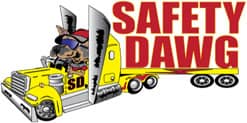Hey, it's Chris Safety Dawg here. Personal Conveyance, that's what we're talking about today. The FMCSA law, Personal Conveyance. Please click like and subscribe to the Safety Dawg channel. I would appreciate it so much, and your comments. I respond personally to your comments, so please leave me a comment at the end of this video. I would love to hear from you.
This is personal use of the truck. It is intended as the truly personal use of the truck. It doesn't say that you have to be empty. It doesn't mean that, as in Canada, that you have to be untethered, or without a trailer. You can take your trailer with you. You could take your load with you if you had other deliveries on there. You can take everything down to the nearest safe resting place along that route. Sorry. The key here is whether or not you know where your next dispatch is going, the keywords that I want to emphasize to you is the nearest safe resting place. If your route is heading south-bound, and there's a resting place 30 miles in that direction, but the nearest safe resting place is five hours, or sorry, five miles north-bound, you'd better go north-bound. Okay.
Now, if you're not aware of your next dispatch, and you go to the nearest safe resting place to that shipper's location or the receiver's location, or wherever it is that you are, and you happen to go five miles north-bound because that was the nearest safe location, and when you receive your dispatch, you happen to be going north-bound, and you benefited, that would be ruled okay because again, the police are just merely going to look at where you were and where you are now, where is the nearest safe place. The commercial police, they know where those safe places are, and they will treat it accordingly.
In some instances, it may be a benefit, but in most cases, you'd better go to the nearest safe location. That is all. This is what the law says here if we go back to that. The driver may not be aware of the direction of the next dispatch, and that in some instances, the nearest safe resting location may be in the direction of that dispatch. But again, they use the words, nearest safe location. If the driver proceeds to the nearest reasonable and safe location and takes the required rest, this would qualify as Personal Conveyance. That is what the law says. Personal Conveyance. Use it carefully and make sure it is to your nearest safe resting place.
If you are out of hours, how do you record it in your log book? The word is annotated. Annotate on your log, which means make a note on your log. So, if you're using ALDs, you have to put a note in. If he or she cannot park at the nearest location and must proceed to another location, annotate the log. In both cases, you have to make notes on your log. If you go to the nearest safe location, and we all know that there's a parking crisis, if the parking lot was full and you had to proceed to another nearest safe location, then you have to annotate your log. Again, please make sure you're going to the nearest safe location, not to the location that is most convenient to you. Th police are not gonna look at convenience. They're gonna look at the wording of the law and apply it accordingly if it's to the nearest safe location.
Now here's the wow factor because I didn't think they would put this into law, but they have. When a safety official, such as a law enforcement officer, requires a driver to move during an off-duty period, no farther than the nearest reasonable and safe area to complete the rest period. Again, if a police officer says, "Driver," for whatever reason, "you've got to move," and you've already started your 10 hour off-duty period, you now can. And again, annotate your log, but you can go no further than to the nearest reasonable and safe area to complete that rest.
So we have shippers and receivers where you cannot park, and you run out of hours, you can now get to the nearest reasonable safe location, and if you were parked somewhere and for some reason a police officer asked you to move, asked you, please, put a smile on my face, told you to move, in the old days that used to break up your 10 hours off duty. Now it doesn't. You mark it as Personal Conveyance. You put it on your log book. And that is everything that you need to know about Personal Conveyance. That's Safety Dawg. Please subscribe to the channel. Click like. Leave me your comments. I respond to them all. That's it for me. Safety Dawgs out.
